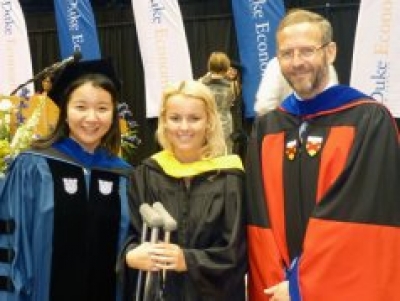
12 September 2014 10:03AM
Gabrielle Inder ’14 was already recognized for her honors thesis when she graduated with a high distinction in economics. But nearly half a year after earning her bachelor’s with a finance concentration and moving to New York to work for Morgan Stanley, Inder is now being highly commended by The Undergraduate Awards 2014 for an abridged version of her capstone project.
The UA is a pan-discipline academic awards program that identifies leading creative thinkers through their undergraduate coursework. This year the UA program received 4,792 submissions from undergraduate students around the world. As a highly commended entrant, Inder’s essay ranks in the top 10 percent of submissions to the 2014 program.
Inder’s paper, entitled “Exceeding the Threshold: Analysis of Public Information Transfer Using Instrumental Variables,” focuses on the environmental implications of certain toxic chemicals and their impact on neighborhood house pricing.
According to the native New Zealander, minoring in chemistry helped her take an interdisciplinary approach to the topic at hand. “Having studied chemistry at Duke, I brought an additional comprehension of the chemical structures, potential interactions, and safety implications of those toxic chemicals’presence in soil, ground water, air, and sediment sources.”
Inder said the news of her paper’s ranking was “completely unexpected,” but her senior thesis advisor was not surprised.
“Gabby she put in a tremendous amount of work over the course of her senior year,” said Professor Chris Timmins. “She created a unique data set from scratch with information content that rivaled what professional economists used, and she went above and beyond the standard undergraduate training with the econometric methods that she used to evaluate the data.”
Inder said she submitted her work to The Undergraduate Awards (UA) because it “presented the chance to not only expand the audience of my personal research, but also to notify the global community of the amazing opportunities available at Duke to engage in research at an undergraduate level.”
Many of the resources available through Duke University and the Department of Economics proved to be incredibly helpful during the research process, Inders said. Members of the faculty, Timmins and Professor Michelle Connolly, and recent doctoral graduate Lala Ma ’14 served as her advisors and mentors. And library staff at the Data and Visualization Services (DVS) lab in Perkins Library helped her with the GIS software used to map the distance between each individual house to nearby brownfield sites.
In addition to the actual written thesis, the result of Inder’s labor-intensive work was a data set that she hopes will be used by others for future research. Inder said she read through thousands of pages of EPA reports, collected chemical levels, and recorded it all into a “giant spreadsheet.
“It is an incredible feeling to be ranked in the top 10 percent of submissions to the program,” she said. “It’s gratifying to know that all of the hard work that my advisors and I put in over the past 12 to 18 months has paid off, and that the work is being recognized on an international level.”
As part of the UA program’s recognition, Inder is in the running to be named one of the year’s winners and has been invited to the UA Global Summit in Dublin, Ireland in November.
“I would be lying if I said I wasn’t both nervous and excited to hear about the winners results on Sept. 22,” she said. “However, I am proud to have been selected as a highly commended student, and look forward to reading the submissions of the other commended students when they are published by the UA later in the year!”
The following is the abstract from Inder’s honors thesis.
This paper examines how information transfer about contamination levels found at brownfield sites capitalizes into nearby property values. More specifically, a hedonic model is used to test the impact on housing transaction prices when a binary measure (i.e. exceeding a threshold or not) or a continuous measure (i.e. chemical levels) is used. In the analysis, I exploit the variation in the contaminant thresholds, caused by regulatory conditions defined by the state of Massachusetts, holding the contaminant level constant. As thresholds are tied to neighborhood attributes in areas surrounding brownfields, threshold exceedance is potentially correlated to unobserved factors that impact housing values. An instrumental variables approach is used to create variation in threshold exceedance through the use of an instrument that measures the presence to underground aquifers. After instrumenting for threshold exceedance, my estimates indicate that a 10.8% decrease in housing values occurs when a contaminant threshold is exceeded, while the continuous measures of toxicity indicate a negative but insignificant effect. These findings suggest that policy makers should consider information conveyance when creating policies to inform homeowners of pollution presence, as improved information provision may increase public awareness about local environmental concerns.
Learn more about our undergraduate and honors thesis programs.